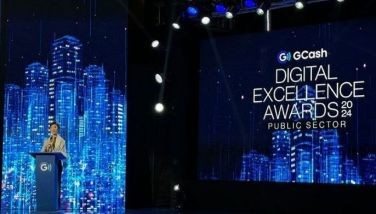Romance in the next century (and other future shockers)
February 11, 2003 | 12:00am
 The Pop Shoppe is crowded with people needing a little pick-me-up after the foul weather.
The Pop Shoppe is crowded with people needing a little pick-me-up after the foul weather.
"Wow, so many base feelings to choose from," Vivienne says. "In France, we only have three: light, serious and strawberry ebullience."
"Well, when the FDA took over from Baskin-Robbins, they put a lot into it – years of research. They have 32 classics, 211 blend-ins, with a special formula every week."
The pharmacist takes Daisy’s order – she asks for something in orange, good for energy, with a dash of violet for joy and a hint of cheerination for her temperament.
Vivienne orders straight blue, which enhances your view of yourself and makes your hair shiny. As they’re waiting for their pills, a boy who looks uncannily like Daisy’s mystery date comes in.
Vivienne elbows her, "Vite, look, go tell him he’s your mystery date."
Daisy shakes her head, suddenly shy.
"Monsieur," Vivienne calls to the pharmacist. "Pardon, but who is that boy?" The pharmacist aims his lens at the boy, feeding the image into his screen, and the simple statistics folder of Walter Taylor opens – he’s top of his lot, with a gold star in thermomolecular theory, and his father is an auto mechanic.
"Your dud is a dream," Vivienne says.
"Would you like to hear him play the trombone?" the pharmacist asks. "There’s a sample on file – he’s first chair in the Invisible Band."
The girls swallow their pills, washing them down with shot glasses of water. "Thanks."
The pharmacist comes out from behind the counter and introduces Daisy to Walter. They shake hands.
"This is my friend Vivienne, from France," says Daisy.
"Hi," Walter says. "What kind of pill did you pop?"
"Blue," Vivienne says. "And you?"
"I don’t take anything. I like to have my feelings. I just come here to meet people."
Vivienne yawns. "Pardon." She checks her watch and turns to Daisy. "It’s 3 in the morning in Paris. I should get back."
"Hey," Walter says as the girls are leaving. "Are you free tomorrow night? You could come over for dinner. My mom makes a great meatloaf and we could watch some information or something. I live around the corner on Maple Street."
"Wow," Daisy says, "that sounds great. I’ve never been to someone’s house for dinner before. But I have to check with my mother first."
"Mon Dieu," Vivienne says, rubbing her head as they get into the car. "I shouldn’t have had so much blue. I’m feeling a little overinflated."
From an open window comes the faint sound of theme music – since 2046, you always hear things from the past. All that has ever been said, or done, is constantly replayed. There is no silence. The girls unconsciously hum along: "He’s here, my mystery date. Are you ready? Don’t be late, open the door for your mystery date."
Daisy gushes, "He’s so alive, so human – not like any boy I’ve ever met."
"Oui," Vivienne says. "He is, enfin, finally, something new."
Thus wrote A.M. Homes on the future of romance in the next century in the Sept. 29, 1996 issue of The New York Times Magazine celebrating its 100th year by looking back and looking forward to the next hundred years. The issue also contains an interesting Da Going Out Guide for dating couples in America circa 2096. For one, there’s the museum: Couples can go and catch a "Mo Mo Monet" exhibit at the Da Mitsubishi (formerly Da Metropolitan) Museum, where, lo and behold, they’d see all 18 floors filled with Monet’s works and, yes, Claude Monet himself, reconstituted from the DNA in a strand of his beard, painting haystacks and singing dirty French songs. For another, couples can listen to the sounds around town, like the hotshot, unstoppable alto Netsuhiro Fishscale, who’s album has gone plutonium, so now, he hooks his horn up to a nuclear reactor.
Ready for more future shockers? Don’t look now, but sooner than you think, you’d be shopping for body parts (natural and synthetic) to replace malfunctioning or worn-out organs, thanks to the combined genius of surgeons, geneticists, gerontologists, molecular biologists, immunologists, etc. who have blurred the line between reality and the realm of science fiction. Replacing a damaged body part will just be a minor operation (like a tonsillectomy) with no risks involved. And the replacements will be as good as (or even better than) the original – for instance, artificial arms that have sensory nerves with pressure receptors in fingers that feel (and function) like natural fingers.
More artificial body parts, anyone? What about an artificial placenta, which, by 2020, will make it possible for women to have a child entirely outside the human body, redefining the meaning of motherhood and fatherhood?
By year 2020, body cloning will make possible the duplication of our body parts. Picture this: Those aged 25 to 30 (who have fully developed physically) will pay a visit to some sort of a cosmetic surgeon who will administer local anesthesia and snip a small piece of skin from the underside of their arm. This will be quickly dropped into a glass lab dish filled with enzymes that’ll break the skin tissue into individual cells.
Ten years from now (or sooner), we would be able to perform blood tests on ourselves without drawing blood (certainly welcome news to those who faint at the sight of blood) via medical equipment that are as standard as a television or a microwave. We would also be able to screen ourselves for a wide array of diseases while we’re taking our morning shower or listening to the news.
So, what’s in the medicine cabinet of the future? Here’s a sneak peek, again from The New York Times Magazine’s 1996 anniversary issue:
• Drugs will be more effective, tailored to the individual, and to a wider array of ailments. Homeopathic remedies will shed the stigma that most 20th-century doctors placed on alternative medicines. And the line between pharmaceuticals and cosmetics will continue to blur as beauty aids offer more and more medical relief.
• An all-in-one strategy pills will supply a person’s daily prescription needs in a single swallow. They’re custom-made at the local pharmacy, and specific to the exact strain of the disease and the patient’s gene and blood type.
• When you pass the bar code on your prescription bottles over the cabinet’s scanner, information about the drug and your dosage pops up on the screen.
• A high-pressure blast delivers injections – for everything, from migraines to allergies – without needles.
• A cryogenic dispenser keeps living skin frozen until it is needed for deep wounds. It can also supply the epidermis (or outer layer), genetically engineered to prevent the immune system from rejecting it.
• Toothpaste won’t just remove tartar; it will eliminate the bacteria responsible for tooth decay.
• This melanin cream boosts the body’s natural reserves of melanin, thus offering a more permanent and effective alternative to tanning lotions.
Who knows, the future could be just around the proverbial corner!
BrandSpace Articles
<
>



















